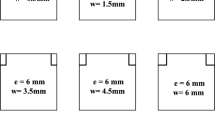Summary
In a typical sawmill, about 12% of the wood which is cut is reduced to sawdust. Further material is lost during subsequent planing. A substantial part of this large loss of a costly natural resource can be saved by the use of thin, stable sawblades, but only if proper saw tensioning conditions are developed. The thickness of a stable sawblade can be minimized through optimal tensioning, an increasingly urgent objective because of sharply rising raw material costs. A theoretical model is presented which accurately describes the development of residual stresses in a roll tensioned circular sawblade and the resulting changes in saw critical speed. This model is essential for the reliable prediction of optimal tensioning conditions for any given saw operating state, and for the development of automated control of the tensioning process. An example is presented of an optimally tensioned circular sawblade for which a 40% thickness reduction is achieved compared with an equivalent untensioned sawblade with the same critical speed.
Similar content being viewed by others
References
Allan, R. K. 1964: Rolling bearings. 3rd Ed. London: Pitman
Beer, R.; Peterschinegg H. 1977: Reckvorspannung in Kreissägeblättern. (Tensioning stresses in circular sawblades.) Österr. Ing.-Z. 20: 155–162
Clephane, T. P.; Carroll, J. 1981: Timber: even non-industry investors realize its value. Forest Ind. 108: 49–51
Eldredge, K. R.; Tabor, D. 1955: The mechanism of rolling friction. I. The plastic range. Proceed. Royal Soc. Ser A, 229: 181–198
Hardy, C.; Baronet, C. N.; Tordion, G. V. 1971: The elasto-plastic indentation of a half-space by a rigid sphere. International J. Numer. Meth. Eng. 3: 451–462
Harpole, G. B.; Williston, E.; Hallock, H. H. 1979: Investment opportunity: The FPL EGAR lumber manufacturing system. Research Paper FPL 310. Forest Prod. Lab. Madison, Wis.
Hill, R. 1950: The mathematical theory of plasticity. Oxford: Clarendon Press
Kimura, S.; Ando, M. 1974: Studies on tensioning of circular saw by rolling pressure. I. J. Jap. Wood Res. Soc. 20: 196–204
Merwin, J. E.; Johnson, K. L. 1963: An analysis of plastic deformation in rolling contact. Proceed. Instit. Mech. Engin. 177:676–690
Mote, C. D. Jr. 1979: Overview of saw design and operations research: results and priorities. Proceed. 6th Wood Machining Seminar, Univ. of California, Forest Prod. Lab., Richmond, Cal. pp. 11–25
Mote, C. D. Jr.; Nieh, L. T. 1973: On the foundation of circular saw stability theory. Wood Fiber 5: 160–169
Mote, C. D. Jr.; Schajer, G. S.; Holøyen S. 1981: Circular saw vibration control by induction of thermal membrane stresses. J. Eng. Ind. 103: 81–89
Moyar, G. J.; Sinclair, G. M. 1963: Cumulative plastic deformation in rolling contact. J. Basic Eng. 85: 105–115
Pahlitzsch, G.; Friebe, E. 1973: Über das Vorspannen von Kreissägeblättern. I. (Tensioning of circular sawblades. Part I.) Holz Roh- Werkst. 31: 429–436
Roberts, W. L. 1978: Cold rolling of steel. New York: Dekker
Schajer, G. S. 1979: Circular saw natural frequency program SAWFQ2. Techn. Rep. 35.01.130, No. 13. Univ. of Cal., Forest Prod. Lab., Richmond, Cal.
Schajer, G. S.; Mote, C. D. Jr. 1979: Roll tensioning and residual stress analysis. Proceed. 6th Wood Machining Seminar, Univ. of Cal., Forest Prod. Lab., Richmond, Cal., pp. 295–308
Szymani, R.; Mote, C. D. Jr. 1979: Theoretical and experimental analysis of circular saw tensioning. Wood Sci. Technol. 13: 211–237
Thrasher, E. W. 1972: Eleven million trees wasted annually. Thrasher Publ., Ukiah, Cal.
Timoshenko, S. P.; Goodier, J. N. 1970: Theory of elasticity. 3rd Ed. New York: McGraw-Hill
Tobias, S. A.; Arnold, R. N. 1957: The influence of dynamical imperfections on the vibration of rotating disks. Proceed. Inst. of Mech. Engin. 171: 669–690
Author information
Authors and Affiliations
Additional information
Paper awarded First Place Wood Award Price, Forest Products Research Society, June 1981
Rights and permissions
About this article
Cite this article
Schajer, G.S., Mote, C.D. Analysis of roll tensioning and its influence on circular saw stability. Wood Sci.Technol. 17, 287–302 (1983). https://doi.org/10.1007/BF00349916
Received:
Issue Date:
DOI: https://doi.org/10.1007/BF00349916




